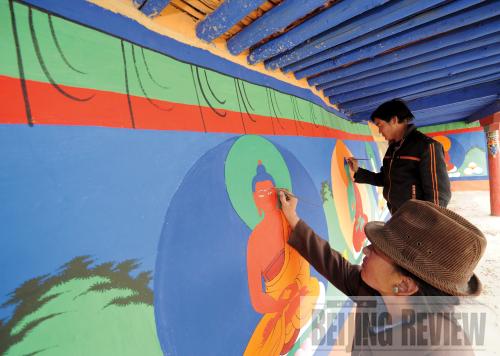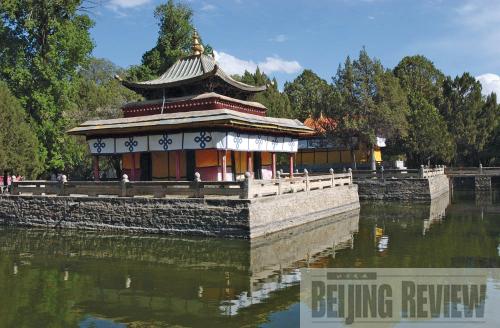|
 |
|
ELABORATE PAINTING: Two craftsmen work on murals in Tibet's Sagya Monastery on May 12, 2009, as the maintenance project draws to a close |
"The Potala Palace is still the same as the one in my memory from childhood," said Namgyi, a Tibetan senior citizen who grew up in Lhasa, capital of Tibet Autonomous Region. Although he learned from the television that the second phase of the palace's renovation has been completed, he said he sees no changes to the original.
The renovation project for the three historic sites, the Potala Palace, the Norbu Lingka Palace and the Sagya Monastery, kicked off in June 2002 under the rule that no changes are made to the original look or the structure of the buildings, and that no other than the original construction techniques were employed. In the past seven years, construction experts have made great efforts to keep the original look while fixing hidden problems inside the buildings.
Nyima Cering, a leading official of the renovation project, adopted traditional Tibetan construction methods that are different from those used in building modern architecture.
The renewal of the Potala Palace's Shol Village also drew UNESCO's attention. Due to serious damage, the village was far from what it once was. Historians, scholars and experts on ancient construction were invited to study the history of Shol Village and found from the murals of the Potala Palace what it looked like during the reigns of the eighth and 13th Dalai lamas. The research has allowed construction crews to restore the former look of the village.
"The seven-year project has not only solved all the hidden problems existing in the ancient buildings but has also kept the relics inside intact," said Nyima Cering.
 |
|
NEW LOOK: The Central Government has invested more than 70 million yuan ($11.7 million) to renovate the Norbu Lingka Palace | Engineers also combined modern technologies with traditional construction skills to recreate the original look.
"Aga soil" is a traditional Tibetan construction material, made by repeatedly ramming together a mixture of gravel, soil and water, which is used to pave roofs and floors. It appears as solid and smooth as marble, but is not very resistant to water. There are multiple layers of the material on the roof of the Potala Palace, reaching 80 cm in thickness at certain points. But it still leaks when it rains, which also damages the wooden structure and fine murals inside.
Renovations had to resolve the water intrusion and alleviate the pressure of the compounded roofing material on the beams and pillars of the building. Workers removed the original layers of the roofing and then put a flexible waterproof layer before replacing the soil.
"Adopting modern technology improves the development of ancient Tibetan building techniques," said Nyima Cering.
The renovations are the largest undertaking and represent the highest investment in the history of the Tibet Autonomous Region. It requires skills and presents difficulties unparalleled in the history of historic preservation.
| 